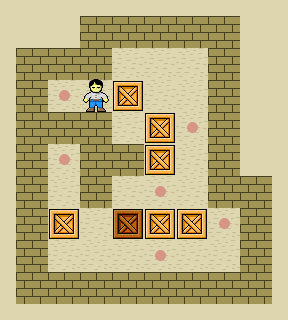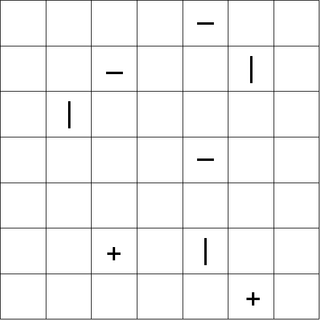
Area is the measure of a region's size on a surface. The area of a plane region or plane area refers to the area of a shape or planar lamina, while surface area refers to the area of an open surface or the boundary of a three-dimensional object. Area can be understood as the amount of material with a given thickness that would be necessary to fashion a model of the shape, or the amount of paint necessary to cover the surface with a single coat. It is the two-dimensional analogue of the length of a curve or the volume of a solid . Two different regions may have the same area ; by synecdoche, "area" sometimes is used to refer to the region, as in a "polygonal area".

Derived from the Greek word for '5', and "domino", a pentomino is a polyomino of order 5, that is, a polygon in the plane made of 5 equal-sized squares connected edge-to-edge. When rotations and reflections are not considered to be distinct shapes, there are 12 different free pentominoes. When reflections are considered distinct, there are 18 one-sided pentominoes. When rotations are also considered distinct, there are 63 fixed pentominoes.

Sokoban is a puzzle video game in which the player pushes boxes around in a warehouse, trying to get them to storage locations. The game was designed in 1981 by Hiroyuki Imabayashi, and first published in December 1982.

In Euclidean plane geometry, a rectangle is a quadrilateral with four right angles. It can also be defined as: an equiangular quadrilateral, since equiangular means that all of its angles are equal ; or a parallelogram containing a right angle. A rectangle with four sides of equal length is a square. The term "oblong" is occasionally used to refer to a non-square rectangle. A rectangle with vertices ABCD would be denoted as ABCD.

Packing problems are a class of optimization problems in mathematics that involve attempting to pack objects together into containers. The goal is to either pack a single container as densely as possible or pack all objects using as few containers as possible. Many of these problems can be related to real-life packaging, storage and transportation issues. Each packing problem has a dual covering problem, which asks how many of the same objects are required to completely cover every region of the container, where objects are allowed to overlap.

Rubik's Magic, like the Rubik's Cube, is a mechanical puzzle invented by Ernő Rubik and first manufactured by Matchbox in the mid-1980s.

The missing square puzzle is an optical illusion used in mathematics classes to help students reason about geometrical figures; or rather to teach them not to reason using figures, but to use only textual descriptions and the axioms of geometry. It depicts two arrangements made of similar shapes in slightly different configurations. Each apparently forms a 13×5 right-angled triangle, but one has a 1×1 hole in it.
Mathematical puzzles make up an integral part of recreational mathematics. They have specific rules, but they do not usually involve competition between two or more players. Instead, to solve such a puzzle, the solver must find a solution that satisfies the given conditions. Mathematical puzzles require mathematics to solve them. Logic puzzles are a common type of mathematical puzzle.

In mathematics, a pyramid number, or square pyramidal number, is a natural number that counts the number of stacked spheres in a pyramid with a square base. The study of these numbers goes back to Archimedes and Fibonacci. They are part of a broader topic of figurate numbers representing the numbers of points forming regular patterns within different shapes.

Bernard Frénicle de Bessy, was a French mathematician born in Paris, who wrote numerous mathematical papers, mainly in number theory and combinatorics. He is best remembered for Des quarrez ou tables magiques, a treatise on magic squares published posthumously in 1693, in which he described all 880 essentially different normal magic squares of order 4. The Frénicle standard form, a standard representation of magic squares, is named after him. He solved many problems created by Fermat and also discovered the cube property of the number 1729, later referred to as a taxicab number. He is also remembered for his treatise Traité des triangles rectangles en nombres published (posthumously) in 1676 and reprinted in 1729.

In recreational mathematics, a polyabolo is a shape formed by gluing isosceles right triangles edge-to-edge, making a polyform with the isosceles right triangle as the base form. Polyaboloes were introduced by Martin Gardner in his June 1967 "Mathematical Games column" in Scientific American.
A dissection puzzle, also called a transformation puzzle or Richter puzzle, is a tiling puzzle where a set of pieces can be assembled in different ways to produce two or more distinct geometric shapes. The creation of new dissection puzzles is also considered to be a type of dissection puzzle. Puzzles may include various restraints, such as hinged pieces, pieces that can fold, or pieces that can twist. Creators of new dissection puzzles emphasize using a minimum number of pieces, or creating novel situations, such as ensuring that every piece connects to another with a hinge.
Stick puzzles are a type of combination puzzle that uses multiple sticks or 'polysticks' to assemble two- or three-dimensional configurations.

Tatamibari is a type of logic puzzle designed and published by Nikoli. The puzzle is based on Japanese tatami mats.

In Euclidean geometry, the British flag theorem says that if a point P is chosen inside a rectangle ABCD then the sum of the squares of the Euclidean distances from P to two opposite corners of the rectangle equals the sum to the other two opposite corners. As an equation:

The inscribed square problem, also known as the square peg problem or the Toeplitz' conjecture, is an unsolved question in geometry: Does every plane simple closed curve contain all four vertices of some square? This is true if the curve is convex or piecewise smooth and in other special cases. The problem was proposed by Otto Toeplitz in 1911. Some early positive results were obtained by Arnold Emch and Lev Schnirelmann. As of 2020, the general case remains open.

In the geometry of tessellations, a rep-tile or reptile is a shape that can be dissected into smaller copies of the same shape. The term was coined as a pun on animal reptiles by recreational mathematician Solomon W. Golomb and popularized by Martin Gardner in his "Mathematical Games" column in the May 1963 issue of Scientific American. In 2012 a generalization of rep-tiles called self-tiling tile sets was introduced by Lee Sallows in Mathematics Magazine.
In geometry, a partition of a polygon is a set of primitive units, which do not overlap and whose union equals the polygon. A polygon partition problem is a problem of finding a partition which is minimal in some sense, for example a partition with a smallest number of units or with units of smallest total side-length.

IM 67118, also known as Db2-146, is an Old Babylonian clay tablet in the collection of the National Museum of Iraq that contains the solution to a problem in plane geometry concerning a rectangle with given area and diagonal. In the last part of the text the solution is proved correct by means of the Pythagorean theorem. The steps of the solution are believed to represent cut-and-paste geometry operations involving a diagram from which, it has been suggested, ancient Mesopotamians might, at an earlier time, have derived the Pythagorean theorem.















